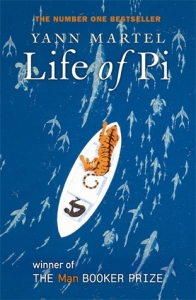Review: Life of Pi, by Yann Martel
March 8, 2015 in General Topics
This kind of setup is ballsy. It’s like if David Copperfield opened his act by showing you the grand finale, then proceeded slowly onward with an exhaustive how-to of the trick involved, betting that he was good enough at his craft and stage show to hold your interest despite his having deflated much of the tension and (forgive the obvious choice of words) magic he was going to employ.
Yann Martel makes that gamble, yet thankfully in many parts of the book it proves successful. This is mostly due to the quality of the world creation. From details of Piscine’s childhood at the fictional Pondicherry Zoo, to the portrayal of the vast reaches of the middle Pacific Ocean, the author weaves a story so rich at times that one can nearly smell its environments.
But ultimately, as the reader progresses, they’ll begin to realize that the tale of survival is a construct designed to further the many deep questions the author wants to ask.
I’ve no problem with fiction that dares grasp at life’s greatest questions, and I’m not docking Martel’s work because he does it. That isn’t my point of contention. My problem is how often the author interrupts the flow of his book to force these big-picture items into frame. One has to be very, very good to pull off spending so much time in a novel veering off the billed main attraction. Martel, I think, only somewhat succeeds at this task. To put it bluntly, Pi’s voyage into multiple religions was as subtle as the hyena that features early on. This wasn’t the ride we were promised; it’s a long, long detour through “It’s a Small World” when one likely bought the book for a white-knuckle ride on “Space Mountain”.
Since the author is obviously inviting discussion on faith, here’s my take on Pi’s multi-theological stance.
It’s faith on a buffet line, where one devours the dishes and ignores all the substance, the details of their selections. It’s lazy. I don’t buy it, either in general or that Pi would embrace it. We can’t say simple childlike innocence compelled Pi to imagine that three different faiths can be embraced simultaneously, because Pi isn’t that vapid, or at least shows no signs of being that naive. Here’s a child that can recall, from memory, an exhaustive cargo manifest of their lifeboat’s possessions, can survive nearly a year at sea with a Bengal tiger, yet breezes past three different religions’ inherent incompatibilities with each other almost like he’s holding his ears and shutting his eyes during the experience. That doesn’t jive with a character who survives precisely because he notices every detail.
Looking past Pi the character, it’s easy to see that the book’s philosophy could have only helped sell copies. Like it or not, we live in a time where two great movements are smoothing over what they see as the bumps that go against their takes on religion. On one side of the coin, we have the Oprahs of the world, who want to pretend that supplicants can simply embrace a faith and ignore vast swathes of its doctrine that directly contradict what they desperately want to believe–that all roads lead to salvation. On the other, we have the modern atheist movement, populated by very bright people, but whose numbers also contain those who nevertheless persist in imagining that all religions are inherently the same–a bit like arguing all schools of political thought are inherently the same because their practitioners often want to pursue public office. That both groups persist in incongruent, reductionist views of religion speaks to the intense emotional appeal of the same stance that gripped young Pi, and that gripped them. It lends a certain irony to Pi’s statements about brothers of a different faith (even though that particular statement is, I think, accurate).
As a matter of fact, Pi is a book I found myself agreeing with a lot, but vehemently disagreeing with again in other instances. I suspect that reaction was one of Martel’s goals, and many of the events in the book–such as the algae island and the interview with the auditors at the end–are of course allegorical devices used to explore the nature of Faith and Disbelief as Martel Sees It.
That’s brave. That’s bold. But there’s a good adventure buried in the middle of those bookends, and I think it could have been better if the author had resisted indulging himself.
Rating: 3/5


Recent Discussion